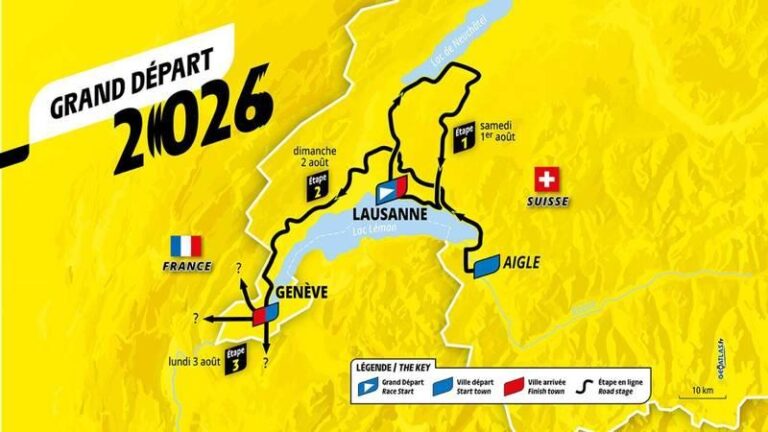As anticipation builds for the 2026 Tour de France, cycling enthusiasts and experts are already spotlighting one rider who seems perfectly poised to dominate the race: Tadej Poga─ıar. Renowned for his exceptional climbing ability, time-trial prowess, and tactical intelligence, Poga─ıar enters the next edition of the world’s most prestigious cycling event at the peak of his career. According to a recent feature in Outside Magazine, the course design and race dynamics of the 2026 Tour appear tailor-made to suit the Slovenian phenom’s strengths, setting the stage for what could be another historic chapter in his already illustrious career.
The 2026 Tour de France Promises Unparalleled Opportunities for Tadej Poga─ıar
The route design for the 2026 Tour de France aligns almost perfectly with Tadej Poga─ıar’s strengths, presenting a course that is both challenging and promising. The organizers have integrated a mixture of steep alpine climbs, technical descents, and time trial stages that emphasize versatility-qualities that have defined Poga─ıar’s racing style. With fewer flat sprint stages and more opportunities to gain time in the mountains and against the clock, the race is set up to reward a rider who excels in endurance, climbing prowess, and strategic precision.
Key elements of the 2026 edition that work in Poga─ıar’s favor include:
- Extended mountain stages featuring iconic summits such as Alpe d’Huez and Col du Galibier.
- Long individual time trials that demand sustained power output.
- Technical descents where bike handling skill can create second gaps.
- Minimal flat terrain limiting opportunities for pure sprinters to steal time.
| Stage Type | Number of Stages | Impact on Poga─ıar |
|---|---|---|
| Mountain | 8 | High – Exploits climbing ability |
| Time Trial | 3 | Crucial for overall lead |
| Flat | 4 | Low – Not Poga─ıar’s forte |
| Hilly | 5 | Moderate – Supports breakaways |
How the Route’s Challenging Climbs Align With Poga─ıar’s Strengths
The 2026 Tour’s route presents a series of punishing ascents, perfectly calibrated to exploit Tadej Poga─ıar’s exceptional climbing prowess. From the steep gradients of the Pyrenees to the relentless alpine pitches, the course features an array of long, sustained climbs where Poga─ıar has repeatedly demonstrated his ability to surge ahead. These climbs don’t just demand raw power; they require tactical nous and a capacity for relentless pacing-attributes where Poga─ıar consistently outperforms rivals. Riders like him thrive when the roads ascend into thin air, turning these mountain stages into decisive battlegrounds for the yellow jersey.
Key elements of the climbs mirror Poga─ıar’s climbing style, highlighted by:
- Steep gradients averaging 7-9%, ideal for his explosive accelerations.
- Varied terrain with multiple back-to-back ascents, testing recovery and endurance.
- Elevation gains exceeding 1,500 meters in single stages, allowing sustained attacks.
- Technical descents following climbs, where his bike handling skills give him strategic advantages.
| Climb | Avg. Gradient | Length (km) | Elevation (m) | Why It Suits Poga─ıar |
|---|---|---|---|---|
| Col de l’├ëpine | 8.2% | 11.3 | 1,200 | Steep pitch matches his punchy attack style |
| Mont├®e de Saint-Gervais | 7.5% | 14.5 | 1,400 | Long endurance climb favors his stamina |
| Pra-Loup Summit | 9.0% | 10.2 | 1,550 | Sharp gradients ideal for time-gaining attacks |
Strategic Recommendations for Poga─ıar and Team UAE to Capitalize on the Course Profile
To maximize the advantage offered by the 2026 Tour de France route, Tadej Poga─ıar and Team UAE must adopt a multifaceted strategy that aligns with the course’s demanding terrain. Prioritizing aggressive climbing tactics during the high mountain stages will be essential, leveraging Poga─ıar’s proven ability to outpace rivals on steep gradients. Equally important is mastering the time trials where seconds can dictate the general classification battle-exploiting aerodynamic equipment and pacing strategies customized for each segment will give Poga─ıar a critical edge. Additionally, targeted energy conservation during transitional flat stages will allow him to stay fresh and explosive when the need arises.
Team UAE’s support framework will play a pivotal role in executing this vision. Key elements include:
- Domestique Deployment: Assigning riders to shelter Poga─ıar from wind and keep him protected in the peloton is vital during early stages.
- Mountain Domination: Sending strong climbers ahead to control breakaways and pace the peloton on ascents.
- Nutrition and Recovery: Customizing feeding schedules and recovery protocols to ensure peak performance throughout consecutive stages.
| Stage Profile | Key Opportunity | Recommended Tactics |
|---|---|---|
| High Mountain | Maximize Time Gains | Attacking on Final Climbs |
| Flat Transitional | Energy Conservation | Drafting & Team Protection |
| Individual Time Trial | Defend or Extend Lead | Optimal Pacing & Equipment |
Final Thoughts
As the 2026 Tour de France approaches, all eyes will be on Tadej Poga─ıar to see if he can translate the race’s demanding terrain into another defining chapter of his already remarkable career. With stages that favor climbers and time-trial specialists, the route appears perfectly aligned with Poga─ıar’s strengths, setting the stage for a potentially historic performance. Whether he will rise to the occasion and cement his legacy as one of cycling’s greats remains to be seen, but one thing is certain: the story of the 2026 Tour will be inseparable from the narrative of this exceptional rider.




